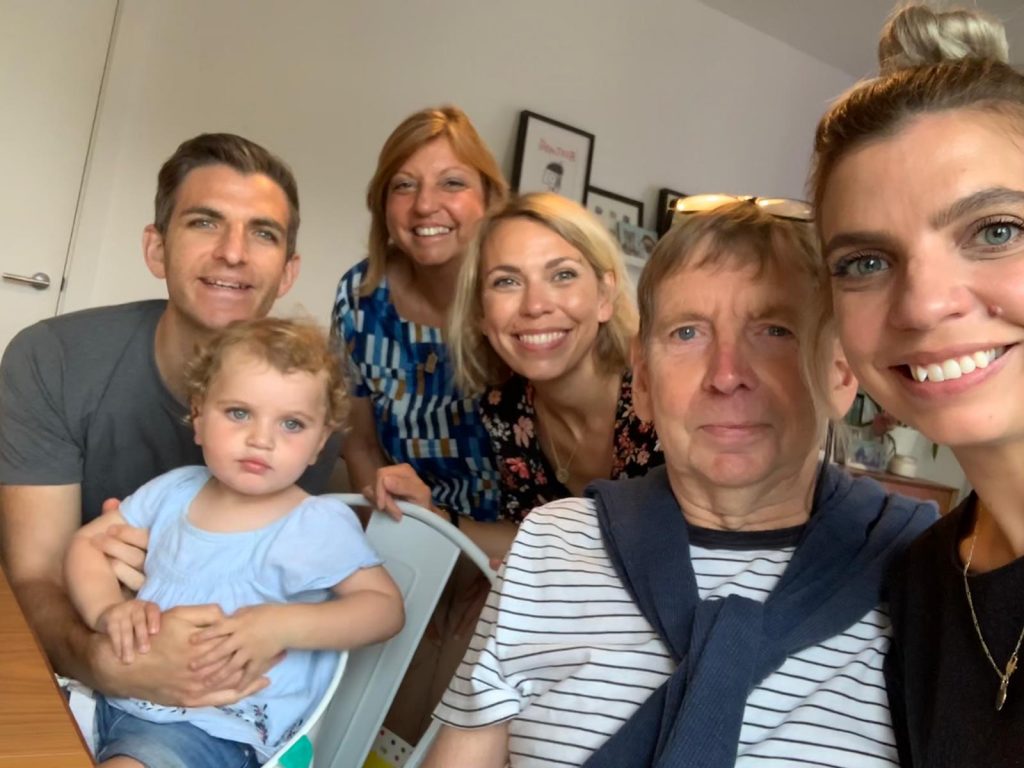“First and foremost, I’m his wife” – Dawn’s story
When your partner is diagnosed with a brain tumour, everything changes. The added responsibilities, worries and fears can result in you feeling more like a carer than a partner, and their treatment and diagnosis can mean they’re seen first and foremost as a ‘brain tumour patient’ and not the person you love.
Below, Dawn shares her open and honest story as the wife of a GBM patient, and how she and her husband Paul have adapted to life following his diagnosis. The couple refuse to be defined by Paul’s brain tumour. Despite immense challenges, fear and uncertainty about their future, Paul, Dawn and their family are remembering to live for today and love every moment of it.
A wife’s story

How I wish it had been a fuss over nothing
A cancer diagnosis invariably knocks everyone for six. For the patient, their family and friends life will never be the same. On Sunday 28th September, 2014, it happened to our family.
For a day or two Paul, my 59 year old, fit and I thought healthy husband, had been complaining of a headache that paracetamol couldn’t shift. As he had never suffered from headaches in the past, I had a nagging feeling that something wasn’t right. I phoned 111 to ask for advice. They ended up sending an ambulance. I am embarrassed to say that at this point I panicked, thinking I had caused unnecessary fuss over a minor headache. Oh, how I wish that it had been a fuss over nothing, ‘a needless waste of precious NHS resources by the worried well’.
Paul walked to the ambulance and within the hour a CT scan revealed a tumour which would require further investigation. I was numbed by the news, but by then Paul felt much better as the high dose of steroids he had been given had stopped the headache.
Little did I know then that this was how life would be in the future, Paul not really comprehending the seriousness of the diagnosis while the rest of us would flounder in despair. However, Paul’s positive attitude, strength of character and overall loveliness, have proved to be crucial in the years that have followed.
Paul was soon diagnosed with a grade 4, Glioblastoma Multiforme, GBM. They tell you not to Google it and they are right, the outlook is not good. The average survival time is 12-18 months with only 5% of patients surviving more than 5 years. Despite this diagnosis Paul was convinced after treatment for a few months he would soon be better.

Adapting to life after diagnosis
The only aspect that seemed to have an impact on him was not being able to drive. As an auto electrician, running his own business, this was a cruel blow to Paul, and one which he still queries at every Consultants appointment. Especially when he despairs at my inability to be able to park our car, since despite the tumour and radiotherapy having affected his field of vision. Paul is still able to lean over from the passenger seat, take the wheel and park the car better than I ever can.
Personality change
The tumour and treatment have certainly had an impact on Paul’s personality, draining his confidence and making him more fearful about life. The man who in the past other people would turn to in order to sort things out, has become someone who needs support. But throughout it all Paul has been determined to make the most of what he can do.
There are occasions when Paul does become demoralised about his situation, angry and self-critical at what he sees as his shortcomings and I have to remind him to cut himself some slack and celebrate how much he is doing with a brain which has been cut by a scalpel, burnt by radiotherapy and poisoned by chemotherapy. In fact it’s amazing what he and other brain tumour patients do manage to achieve.
Paul has always been a caring and thoughtful man and I don’t know whether it’s the tumour, the treatment or just life, but this aspect of his character has really come to the fore. Paul now goes out of his way to talk to people, previously quite a reticent man, now he will strike up conversations with anyone and everyone, always concerned for their welfare. Paul especially likes to connect with those he regards as ‘forgotten’ or ‘disregarded’.
When shopping he will go out of his way to talk to the security guards, asking them about their day and how their life is going. Saying he feels sorry for them standing around all day, being ignored. There have been occasions when I have seen them initially regarding him with suspicion, perhaps they think he is acting as a decoy taking their attention while I go on a shoplifting spree.
The appearance of this softer side of Paul’s personality has bought us closer together in our film preferences as he has started to enjoy rom coms and musicals. I have since found this is not unique, the wife of another GBM sufferer said her husband had quite taken to watching the film Notting Hill over and over.
Claustrophobia
Paul and I had always led a very ‘together life’ spending as much time together as possible. Since the tumour, I have reappraised our relationship; what we had before was a companionably close but we were still very much individuals, each with our own busy life. We now spend virtually every waking and sleeping hour together and this combined with the weight of a serious diagnosis can make life claustrophobic at times. Paul always encourages me to meet up with my friends, but I find it difficult to leave him on his own without feeling anxious for his safety and welfare.
This Coronavirus lockdown has given everyone a taste of what it’s like to live in our world.
The tumour has resulted in Paul and I taking on different roles. I dislike being seen as Paul’s ‘carer’, even though I often use the term to describe myself. I am first and foremost Paul’s wife and he is my husband not my patient. Getting the balance right can be difficult. Even more so where the tumour and treatment has impacted on speech and comprehension.
Hospital highs and lows
The past six years has also given us a 360 degree view of the NHS. There have been highs – operations involving ground breaking brain mapping and dyes enabling the surgeon to declare the tumour completely clear of cancerous cells. And there have been lows, such as a blue light journey to Kings College Hospital in the early hours of the morning, only for the ambulance to break down on the motorway resulting in an unconscious Paul being transferred between ambulances on the hard shoulder of the motorway.
I know there would never be time, but I would love to have an appointment on my own with the Consultant to ask awkward questions.
We soon learned that the most important person in the hospital is the neuro-oncology clinical nurse specialist. They take time to explain what is going on, they put us at ease, deal with practicalities of medication and scans and most importantly at the times when the world is a very dark place, they have put their arms around us and offered comfort.
Wife, PA, carer…
I soon learned that there is rarely time for doctors to read patient files. Acting almost as Paul’s PA I have to have an encyclopaedic knowledge of past and ongoing medical crises, treatments and medication. In fact when brain cancer patient survival rates are compiled I don’t know how much consideration is given as to whether the patient has family or friends to support them throughout their treatment. Not just to explain problems during consultations and supervise medication, but also to deal with the practicalities of appointments; Paul could never queue for an hour in the cold outside the medical centre at 7am waiting for it to open in order to make an ‘on the day appointment’ with the GP. Neither could he deal with the lengthy telephone appointment booking system.
The importance of a brain tumour patient being accompanied to appointments was highlighted recently. Paul was wrongly given a blood test instead of a hormone injection for his prostate cancer treatment because the GPs lockdown regulations meant Paul had to attend alone. Needless to say I will be with him in future.
Treating the person, not just their brain tumour
Its infuriating how each specialist doctor looks at Paul one bit at a time. I wish Paul could have time with a doctor to go over him from top to toe as he is more than just a brain tumour. Likewise the grade 4 diagnosis overshadows everything else: Paul’s prostate cancer symptoms were downplayed for years until I pointed out that ongoing lack of treatment would probably result in him dying of a treatable cancer because of an untreatable one.
I learned that hospital departments do not seem communicate with each other. On a number of occasions including being admitted for a stroke, seizure and shingles. Paul’s oncology consultant only knew because I told her even though all the departments are in the same hospital.
The strength of community

Paul’s tumour has emphasised the importance of family and friends. Our daughters have been wonderful throughout it all, showing unstinting love and support. Their response to seeing their much loved father so seriously ill and so much changed is to surround us with care and kindness.
The power of their love is strong. The girls have certainly been Paul’s focus and reason for wanting to live from the very beginning. A wedding and the arrival of a granddaughter have been the icing on his survival cake.
The wider family have been a constant support both emotionally and practically. Likewise with friends and neighbours who have gone above and beyond what could be expected for friendship.
The brain tumour community has been amazing, there has been much love and laughter along the way in our support groups.
Unhelpful narratives: ‘healing powers of broccoli’
As for brain cancer in relation to the wider world, I have to confess that there have been times in general conversation when sorrow is being expressed at Paul’s condition I do point out that everyone is going to die, even vegans who exercise regularly. Paul has always eaten well and exercised regularly but since his illness I actively avoid reading about or watching TV programmes on foods or lifestyles which claim to prolong life or prevent diseases. Broccoli does not cure cancer, if it did, Paul would never have developed a brain tumour as it has long been his favourite vegetable. Of course a positive attitude helps, and I’m sure it has played some part in him defying the very poor odds of GBM survival so far.
However, I am sometimes uncomfortable with the term ‘fighting cancer’. It infers that the patient has a means of control over it. It can just leave those who have the misfortune to contract cancer with a feeling that it has somehow been their fault and if the disease takes hold they have somehow been inadequate in some way. Oncology waiting rooms certainly opened my eyes to the cruel way cancer gets people in its sights, no one is spared.
A general observation with regard to brain tumours and popular culture. Considering how rare they are, brain tumours do seem to pop up regularly on screen, I can only think the scriptwriters feel brain cancer strikes fear and the actor won’t need any props.
A shift in perspective
Paul’s tumour has caused me to reappraise what I consider as being ‘lucky’ or ‘fortunate’. Although Paul has a terminal diagnosis he was lucky that his tumour could be operated on to give him some extra time. The location of his tumour has been in some ways fortunate, a different location and Paul’s character change might have been very different and he might have become very antisocial, when in fact the very opposite happened.
None of us know what the future will bring, so Paul and I are living for today and making sure we love every moment of it.










